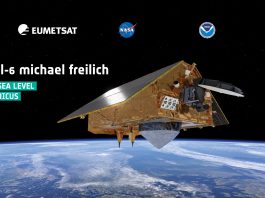NASA has announced the first results of the Sentinel-6 Michael Freilich, a joint US-European satellite built to measure global sea surface height.
Since the successful launch on 21 November 2020 aboard a Space-X Falcon 9 rocket, engineers and scientists have spent several weeks monitoring the satellite’s instruments. Sentinel-6 Michael Freilich follows a continued effort to measure global sea surface height from space, which started in the early 1990s. Since then, the rate of sea level rise has doubled. At the current rate, the sea level is rising 0.16 inches per year. The rise is caused almost entirely by a combination of meltwater from land-based glaciers and ice sheets and the fact that seawater expands as it warms.
Karen St. Germain, director of NASA’s Earth Science Division, said: “Data from Sentinel-6 Michael Freilich will help us evaluate how the Earth is changing. When we combine the data from instruments like the altimeter on Sentinel-6 Michael Freilich with data from other satellites like GRACE-FO and IceSat-2, we can tell how much of the sea level rise is due to melting ice and how much is due to expansion as the oceans warm. Understanding these underlying physical mechanisms is what allows NASA to improve projections of future sea level rise.”
The initial orbit for Sentinel-6 Michael Freilich was 11.4 miles lower than its ultimate operational orbit of 830 miles above Earth. Engineers plan to move the satellite into its operational orbit by mid-December, where it will trail the Jason-3 satellite. During this tandem flight, scientists and engineers will spend the next six to 12 months cross calibrating the data collected by both satellites to ensure the continuity of measurements between the two. Once assured of the data quality, Sentinel-6 Michael Freilich will then become the primary sea level satellite. The first publicly available sea level data will be available in about six months, with the rest available within a year.
Manfred Lugert, programme manager for the Sentinel-6/Jason-CS (Continuity of Service) mission at the European Organisation for the Exploitation of Meteorological Satellites (EUMETSAT), said: “We are now gearing up the operational systems supporting the processing of the instruments’ data by EUMETSAT and partner organisations, as they are all contributing to this complex process. This will keep us busy for the next few months, as the independent scientific validation and fine tuning need to be undertaken very carefully.”









